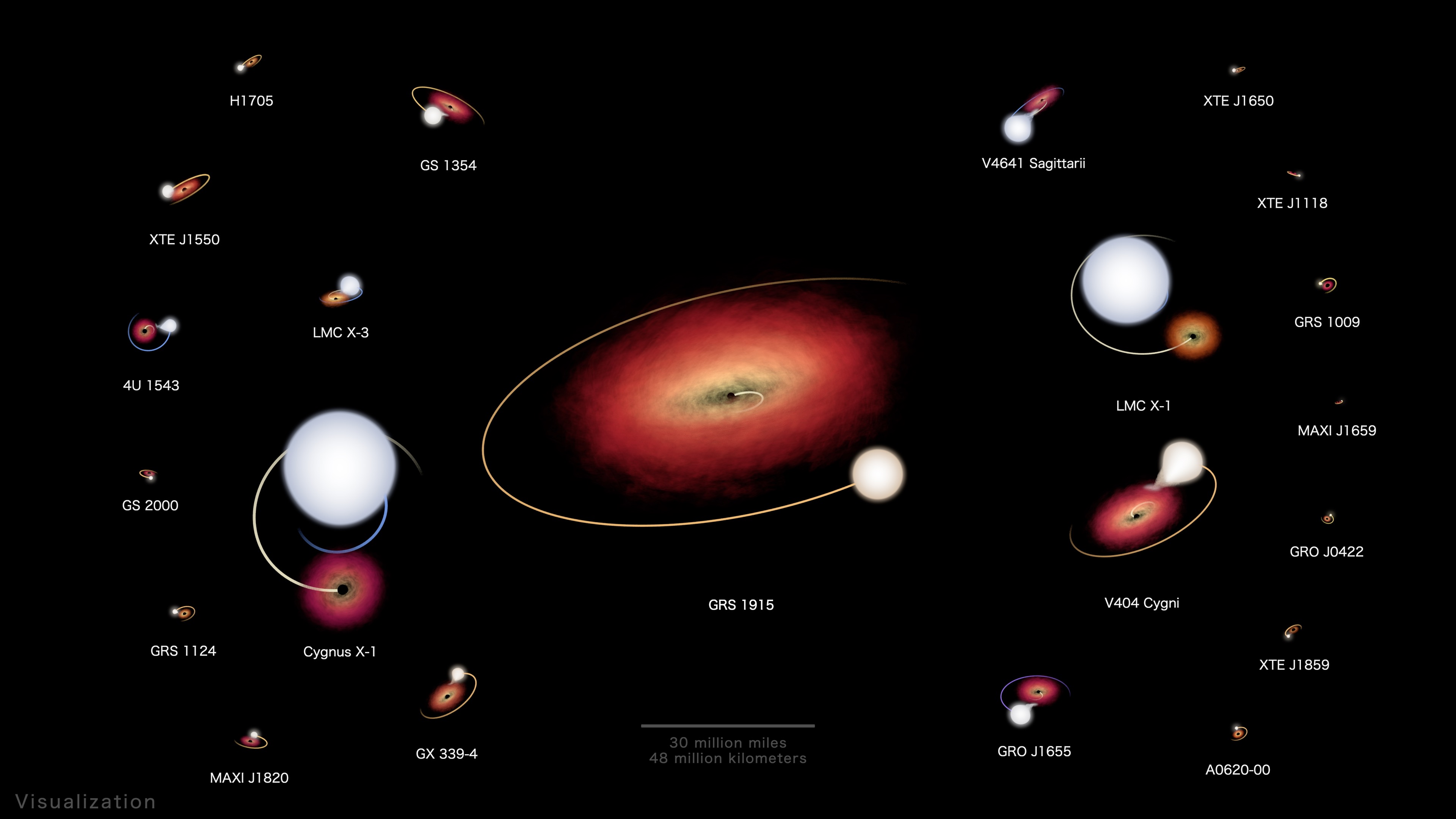X-ray Echoes Create a Black Hole Bull's-eye

Rings of X-ray light centered on V404 Cygni, a binary system containing an erupting black hole (dot at center), were imaged by the X-ray Telescope aboard NASA's Swift satellite from June 30 to July 4. A narrow gap splits the middle ring in two. Color indicates the energy of the X-rays, with red representing the lowest (800 to 1,500 electron volts, eV), green for medium (1,500 to 2,500 eV), and the most energetic (2,500 to 5,000 eV) shown in blue. For comparison, visible light has energies ranging from about 2 to 3 eV. The dark lines running diagonally through the image are artifacts of the imaging system.
Credit: Andrew Beardmore (Univ. of Leicester) and NASA/Swift
What looks like a shooting target is actually an image of nested rings of X-ray light centered on an erupting black hole. On June 15, NASA's Swift satellite detected the start of a new outburst from V404 Cygni, where a black hole and a sun-like star orbit each other. Since then, astronomers around the world have been monitoring the ongoing light show.
On June 30, a team led by Andrew Beardmore at the University of Leicester, U.K., imaged the system using the X-ray Telescope aboard Swift, revealing a series concentric rings extending about one-third the apparent size of a full moon. A movie made by combining additional observations acquired on July 2 and 4 shows the expansion and gradual fading of the rings.
Astronomers say the rings result from an "echo" of X-ray light. The black hole's flares emit X-rays in all directions. Dust layers reflect some of these X-rays back to us, but the light travels a longer distance and reaches us slightly later than light traveling a more direct path. The time delay creates the light echo, forming rings that expand with time.
Detailed analysis of the expanding rings shows that they all originate from a large flare that occurred on June 26 at 1:40 p.m. EDT. There are multiple rings because there are multiple reflecting dust layers between 4,000 and 7,000 light-years away from us. Regular monitoring of the rings and how they change as the eruption continues will allow astronomers to better understand their nature.
V404 Cygni is located about 8,000 light-years away. Every couple of decades the black hole fires up in an outburst of high-energy light. Its previous eruption ended in 1989.
The investigating team includes scientists from the Universities of Leicester, Southampton, and Oxford in the U.K., the University of Alberta in Canada, and the European Space Agency in Spain.

Same as above, but 560 pixels across.
Credit: Andrew Beardmore (Univ. of Leicester) and NASA/Swift

Same as above, but 2252 pixels across.
Credit: Andrew Beardmore (Univ. of Leicester) and NASA/Swift

Rings of X-ray light centered on a binary system containing an erupting black hole (dot at center) were imaged by the X-ray Telescope aboard NASA's Swift satellite on June 30. A narrow gap splits the middle ring in two. Color indicates the energy of the X-rays, with red representing the lowest (800 to 1,500 electron volts, eV), green for medium (1,500 to 2,500 eV), and the most energetic (2,500 to 5,000 eV) shown in blue. For comparison, visible light has energies ranging from about 2 to 3 eV. The dark diagonal lines through the image are artifacts of the imaging system.
Credit: Andrew Beardmore (Univ. of Leicester) and NASA/Swift

The Swift X-ray image of V404 Cygni covers a patch of the sky equal to about half the apparent diameter of the full moon. This image shows the rings as they appeared on June 30.
Credit: NASA's Scientific Visualization Studio (left), Andrew Beardmore (Univ. of Leicester) and NASA/Swift (right)

Swift XRT image of V404 Cygni showing the acquired at 10:52 UT on June 30, 2015. The exposure was about 17 minutes. The field of view is 20 arcminutes across, or two-thirds the apparent diameter of a full moon. Color indicates the energy of the X-rays, with red representing the lowest (800 to 1,500 electron volts, eV), green for medium (1,500 to 2,500 eV), and the most energetic (2,500 to 5,000 eV) shown in blue. For comparison, visible light has energies ranging from about 2 to 3 eV. The dark diagonal lines through the image are artifacts of the imaging system.
Credit: Andrew Beardmore (Univ. of Leicester) and NASA/Swift

Swift XRT image of V404 Cygni showing the acquired at 10:51 UT on July 2, 2015. The exposure was about 27 minutes. Additional information is the same as above.
Credit: Andrew Beardmore (Univ. of Leicester) and NASA/Swift

Swift XRT image of V404 Cygni showing the acquired at 09:02 UT on July 4, 2015. The exposure was about 25 minutes. Additional information is the same as above.
Credit: Andrew Beardmore (Univ. of Leicester) and NASA/Swift
Credits
Please give credit for this item to:
NASA's Goddard Space Flight Center. However, individual items should be credited as indicated above.
-
Producer
- Scott Wiessinger (USRA)
-
Science writer
- Francis Reddy (University of Maryland College Park)
-
Graphics
- Francis Reddy (University of Maryland College Park)
Release date
This page was originally published on Thursday, July 9, 2015.
This page was last updated on Wednesday, May 3, 2023 at 1:49 PM EDT.

